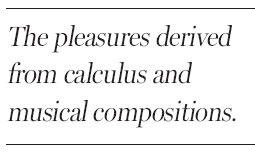Sad music and circles
Updated: 2013-09-29 07:25
By Tom Brady(The New York Times)
|
|||||||
While playing those Baby Mozart CD's to your child may have produced neither a math nor a music prodigy, some scientists say both subjects are fundamental to who we are as humans and can bring us joy. (Though most of us would pick a song over an algebra problem.)
Manil Suri, a professor in Baltimore, Maryland, thinks math can be fun and that on some level humans crave the order it brings. Like many mathematicians, he believes humans are wired for it.
To prove his point, Professor Suri suggests that we envision a sequence of regular polygons: a hexagon, an octagon, a decagon and so on, and imagine the number of sides increasing indefinitely. "Eventually, the sides shrink so much that the kinks start flattening out and the perimeter begins to appear curved," he wrote in The Times. "And then you see it: what will emerge is a circle, while at the same time the polygon can never actually become one.
"The realization is exhilarating - it lights up pleasure centers in your brain," Professor Suri added. "This underlying concept of a limit is one upon which all of calculus is built."

We know that music stimulates pleasure centers in our brains. Robert J. Zattore and Valorie N. Salimpoor, neuroscientists in Canada, have used brain imaging to try to find out why.
They found that listening at the peak emotional moments caused the release of the neurotransmitter dopamine, a pleasure response similar to the one we have with food and sex. Dopamine was also released several seconds before the peak moment, called "the anticipation phase."
The interplay between the primitive pleasure center of our brains and the auditory cortex - the part of our brain where we hear and imagine music - helps us to decipher the abstract relationships between sounds, according to Zattore and Salimpoor. They say that these brain circuits accumulate musical information over our lifetimes and allow us to understand the new music we hear based on our memories of other music.
"Composers and performers intuitively understand this," Zattore and Salimpoor wrote in The Times. "They manipulate these prediction mechanisms to give us what we want - or to surprise us, perhaps even with something better."

Sometimes that something better might be a melancholy tune.
Ai Kawakami, a fellow at the Japan Science and Technology Agency, set out with her colleagues to gain a better understanding of sad music. "Musical emotion," she wrote in The Times, "encompasses both the felt emotion that the music induces in the listener and the perceived emotion that the listener judges the music to express."
When researchers questioned subjects who had listened to sad music, the listeners reported that they did not feel the tragic emotion as much as they perceived it. There appears, Ms. Kawakami reported, to be a gap between the two types of emotions.
When we listen to sad music (or watch a sad movie, or read a sad novel), we are not in danger, and experience what can be called "vicarious emotions," she wrote. "When we weep at the beauty of sad music, we experience a profound aspect of our emotional selves that may contain insights about the meaning and significance of artistic experience and also about ourselves as human beings."
For comments, write to nytweekly@nytimes.com.
(China Daily 09/29/2013 page9)